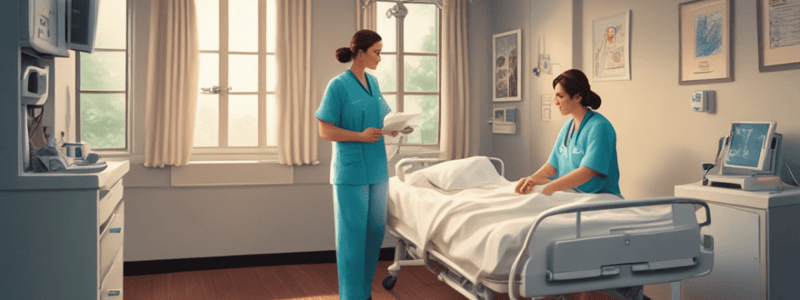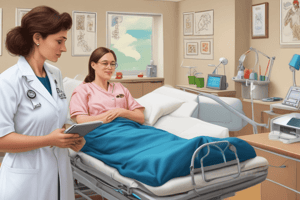Podcast
Questions and Answers
What is the primary goal of patient education?
What is the primary goal of patient education?
- To reduce healthcare costs by minimizing hospital readmissions
- To promote the role of nurses in healthcare
- To train patients to become independent in healthcare
- To help individuals, families, or communities achieve optimal levels of health (correct)
What is the difference between teaching and learning?
What is the difference between teaching and learning?
- Teaching is a one-way process, while learning is a two-way process
- Teaching is imparting knowledge, while learning is applying newly acquired concepts (correct)
- Teaching is the role of the nurse, while learning is the role of the patient
- Teaching is a skill, while learning is a knowledge
What is the outcome of effective communication in teaching?
What is the outcome of effective communication in teaching?
- Feedback from the sender and receiver (correct)
- Increased patient satisfaction
- Patient compliance with treatment plans
- Improved health outcomes
What is the role of the nurse in teaching and learning?
What is the role of the nurse in teaching and learning?
What is one of the purposes of patient education?
What is one of the purposes of patient education?
What is an outcome of patient education?
What is an outcome of patient education?
What is the primary focus of cognitive learning?
What is the primary focus of cognitive learning?
Which of the following is a cultural factor that influences learning?
Which of the following is a cultural factor that influences learning?
What is the primary role of the nurse in patient education?
What is the primary role of the nurse in patient education?
Which of the following is a key principle of readiness to learn?
Which of the following is a key principle of readiness to learn?
In what setting do nurses have more time to identify patients' learning needs?
In what setting do nurses have more time to identify patients' learning needs?
What is the primary focus of psychomotor learning?
What is the primary focus of psychomotor learning?
What is the primary focus of the assessment phase in the nursing process?
What is the primary focus of the assessment phase in the nursing process?
What is the main goal of the planning and outcomes identification phase in the nursing process?
What is the main goal of the planning and outcomes identification phase in the nursing process?
Which of the following is NOT a teaching approach used in the implementation phase of the nursing process?
Which of the following is NOT a teaching approach used in the implementation phase of the nursing process?
What is the main purpose of using the 'teach-back' method in the evaluation phase of the nursing process?
What is the main purpose of using the 'teach-back' method in the evaluation phase of the nursing process?
What is an important consideration when teaching patients with illiteracy or other disabilities?
What is an important consideration when teaching patients with illiteracy or other disabilities?
What is a key factor to consider when teaching patients from culturally diverse backgrounds?
What is a key factor to consider when teaching patients from culturally diverse backgrounds?
What is the primary focus of the implementation phase in the nursing process?
What is the primary focus of the implementation phase in the nursing process?
What is an important consideration when teaching special needs of children and older adults?
What is an important consideration when teaching special needs of children and older adults?
Flashcards are hidden until you start studying
Study Notes
Purposes of Patient Education
- Primary goal of patient education is to help individuals, families, or communities achieve optimal levels of health
- Includes maintenance and promotion of health, illness prevention, restoration of health, and coping with impaired functions
Teaching and Learning
- Teaching involves imparting knowledge through directed activities
- Learning is the process of understanding and applying newly acquired concepts
- Nurses are legally responsible for providing education to all patients
- Effective communication involves feedback from both the sender and receiver
Domains of Learning
- Cognitive learning
- Affective learning
- Psychomotor learning
Basic Learning Principles
- Motivation to learn is crucial, and can be enhanced using theories and considering cultural factors
- Readiness to learn is essential, and can be influenced by active participation
- Ability to learn depends on developmental capability, learning in children, adult learning, health literacy, and learning disabilities
- Learning environment plays a significant role in the learning process
Clinical Judgment in Patient Education
- Knowledge of a patient's health condition and assessment data help predict the topic and level of instruction required
- Identifying patients' learning needs and providing comprehensive ongoing education is crucial in clinic, home care, and rehabilitation settings
- In acute care settings, it's essential to engage patients and family caregivers early in instruction and confirm what they need to learn before returning home
Nursing Process
Assessment
- Includes understanding the patient's perspective, identifying learning needs, motivation to learn, readiness and ability to learn, environmental factors, resources for learning, and health literacy
Analysis and Planning
- Involves analysis and nursing diagnosis, planning and outcomes identification, setting priorities, and timing
Implementation
- Maintaining learning attention and participation, building on existing knowledge and ability, teaching approaches (telling, participating, entrusting, reinforcing), and incorporating teaching with nursing care
- Instructional methods include verbal one-on-one discussion, group instruction, preparatory instruction, demonstrations, analogies, and simulation
- Considerations for illiteracy and other disabilities, cultural diversity, using teaching tools, and special needs of children and older adults
Evaluation
- Focuses on patient outcomes, with a "teach-back" approach to ensure understanding
Studying That Suits You
Use AI to generate personalized quizzes and flashcards to suit your learning preferences.



